Somak Aditya
PragWorld: A Benchmark Evaluating LLMs' Local World Model under Minimal Linguistic Alterations and Conversational Dynamics
Nov 17, 2025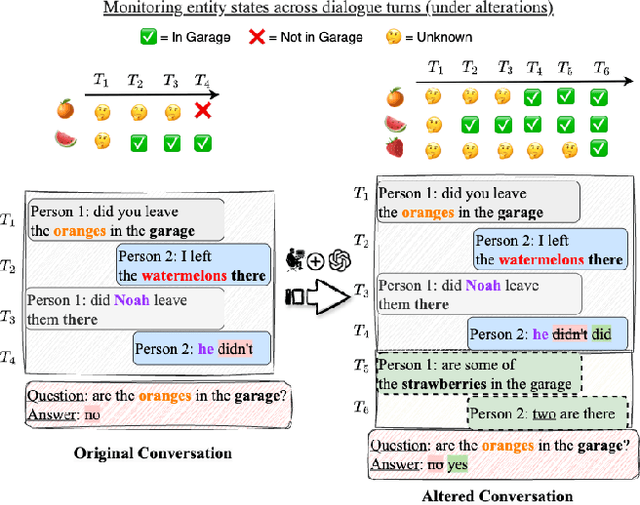
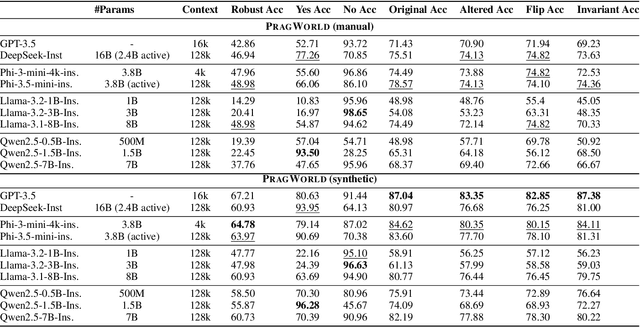
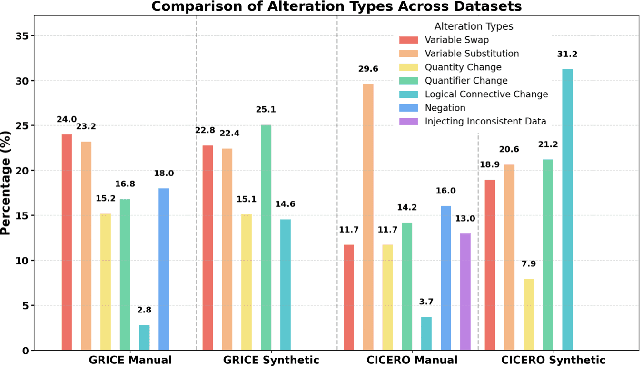

Abstract:Real-world conversations are rich with pragmatic elements, such as entity mentions, references, and implicatures. Understanding such nuances is a requirement for successful natural communication, and often requires building a local world model which encodes such elements and captures the dynamics of their evolving states. However, it is not well-understood whether language models (LMs) construct or maintain a robust implicit representation of conversations. In this work, we evaluate the ability of LMs to encode and update their internal world model in dyadic conversations and test their malleability under linguistic alterations. To facilitate this, we apply seven minimal linguistic alterations to conversations sourced from popular datasets and construct two benchmarks comprising yes-no questions. We evaluate a wide range of open and closed source LMs and observe that they struggle to maintain robust accuracy. Our analysis unveils that LMs struggle to memorize crucial details, such as tracking entities under linguistic alterations to conversations. We then propose a dual-perspective interpretability framework which identifies transformer layers that are useful or harmful and highlights linguistic alterations most influenced by harmful layers, typically due to encoding spurious signals or relying on shortcuts. Inspired by these insights, we propose two layer-regularization based fine-tuning strategies that suppress the effect of the harmful layers.
NLKI: A lightweight Natural Language Knowledge Integration Framework for Improving Small VLMs in Commonsense VQA Tasks
Aug 28, 2025Abstract:Commonsense visual-question answering often hinges on knowledge that is missing from the image or the question. Small vision-language models (sVLMs) such as ViLT, VisualBERT and FLAVA therefore lag behind their larger generative counterparts. To study the effect of careful commonsense knowledge integration on sVLMs, we present an end-to-end framework (NLKI) that (i) retrieves natural language facts, (ii) prompts an LLM to craft natural language explanations, and (iii) feeds both signals to sVLMs respectively across two commonsense VQA datasets (CRIC, AOKVQA) and a visual-entailment dataset (e-SNLI-VE). Facts retrieved using a fine-tuned ColBERTv2 and an object information-enriched prompt yield explanations that largely cut down hallucinations, while lifting the end-to-end answer accuracy by up to 7% (across 3 datasets), making FLAVA and other models in NLKI match or exceed medium-sized VLMs such as Qwen-2 VL-2B and SmolVLM-2.5B. As these benchmarks contain 10-25% label noise, additional finetuning using noise-robust losses (such as symmetric cross entropy and generalised cross entropy) adds another 2.5% in CRIC, and 5.5% in AOKVQA. Our findings expose when LLM-based commonsense knowledge beats retrieval from commonsense knowledge bases, how noise-aware training stabilises small models in the context of external knowledge augmentation, and why parameter-efficient commonsense reasoning is now within reach for 250M models.
AURA: Affordance-Understanding and Risk-aware Alignment Technique for Large Language Models
Aug 08, 2025Abstract:Present day LLMs face the challenge of managing affordance-based safety risks-situations where outputs inadvertently facilitate harmful actions due to overlooked logical implications. Traditional safety solutions, such as scalar outcome-based reward models, parameter tuning, or heuristic decoding strategies, lack the granularity and proactive nature needed to reliably detect and intervene during subtle yet crucial reasoning steps. Addressing this fundamental gap, we introduce AURA, an innovative, multi-layered framework centered around Process Reward Models (PRMs), providing comprehensive, step level evaluations across logical coherence and safety-awareness. Our framework seamlessly combines introspective self-critique, fine-grained PRM assessments, and adaptive safety-aware decoding to dynamically and proactively guide models toward safer reasoning trajectories. Empirical evidence clearly demonstrates that this approach significantly surpasses existing methods, significantly improving the logical integrity and affordance-sensitive safety of model outputs. This research represents a pivotal step toward safer, more responsible, and contextually aware AI, setting a new benchmark for alignment-sensitive applications.
REFINE-AF: A Task-Agnostic Framework to Align Language Models via Self-Generated Instructions using Reinforcement Learning from Automated Feedback
May 10, 2025Abstract:Instruction-based Large Language Models (LLMs) have proven effective in numerous few-shot or zero-shot Natural Language Processing (NLP) tasks. However, creating human-annotated instruction data is time-consuming, expensive, and often limited in quantity and task diversity. Previous research endeavors have attempted to address this challenge by proposing frameworks capable of generating instructions in a semi-automated and task-agnostic manner directly from the model itself. Many of these efforts have relied on large API-only parameter-based models such as GPT-3.5 (175B), which are expensive, and subject to limits on a number of queries. This paper explores the performance of three open-source small LLMs such as LLaMA 2-7B, LLama 2-13B, and Mistral 7B, using a semi-automated framework, thereby reducing human intervention, effort, and cost required to generate an instruction dataset for fine-tuning LLMs. Furthermore, we demonstrate that incorporating a Reinforcement Learning (RL) based training algorithm into this LLMs-based framework leads to further enhancements. Our evaluation of the dataset reveals that these RL-based frameworks achieve a substantial improvements in 63-66% of the tasks compared to previous approaches.
SMAB: MAB based word Sensitivity Estimation Framework and its Applications in Adversarial Text Generation
Feb 10, 2025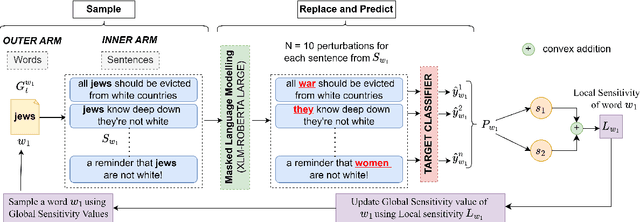
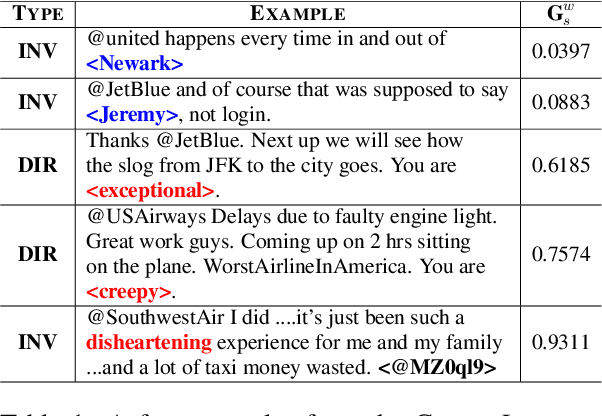
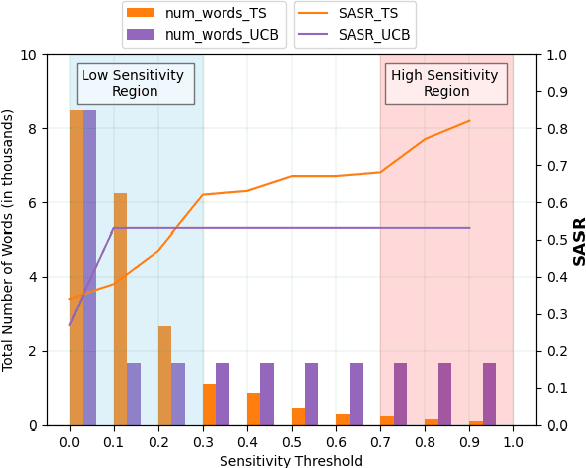
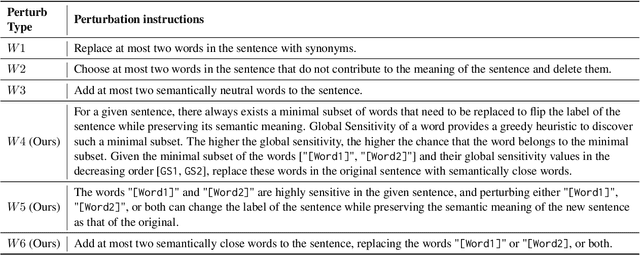
Abstract:To understand the complexity of sequence classification tasks, Hahn et al. (2021) proposed sensitivity as the number of disjoint subsets of the input sequence that can each be individually changed to change the output. Though effective, calculating sensitivity at scale using this framework is costly because of exponential time complexity. Therefore, we introduce a Sensitivity-based Multi-Armed Bandit framework (SMAB), which provides a scalable approach for calculating word-level local (sentence-level) and global (aggregated) sensitivities concerning an underlying text classifier for any dataset. We establish the effectiveness of our approach through various applications. We perform a case study on CHECKLIST generated sentiment analysis dataset where we show that our algorithm indeed captures intuitively high and low-sensitive words. Through experiments on multiple tasks and languages, we show that sensitivity can serve as a proxy for accuracy in the absence of gold data. Lastly, we show that guiding perturbation prompts using sensitivity values in adversarial example generation improves attack success rate by 15.58%, whereas using sensitivity as an additional reward in adversarial paraphrase generation gives a 12.00% improvement over SOTA approaches. Warning: Contains potentially offensive content.
ERVQA: A Dataset to Benchmark the Readiness of Large Vision Language Models in Hospital Environments
Oct 08, 2024Abstract:The global shortage of healthcare workers has demanded the development of smart healthcare assistants, which can help monitor and alert healthcare workers when necessary. We examine the healthcare knowledge of existing Large Vision Language Models (LVLMs) via the Visual Question Answering (VQA) task in hospital settings through expert annotated open-ended questions. We introduce the Emergency Room Visual Question Answering (ERVQA) dataset, consisting of <image, question, answer> triplets covering diverse emergency room scenarios, a seminal benchmark for LVLMs. By developing a detailed error taxonomy and analyzing answer trends, we reveal the nuanced nature of the task. We benchmark state-of-the-art open-source and closed LVLMs using traditional and adapted VQA metrics: Entailment Score and CLIPScore Confidence. Analyzing errors across models, we infer trends based on properties like decoder type, model size, and in-context examples. Our findings suggest the ERVQA dataset presents a highly complex task, highlighting the need for specialized, domain-specific solutions.
Jailbreak Paradox: The Achilles' Heel of LLMs
Jun 18, 2024Abstract:We introduce two paradoxes concerning jailbreak of foundation models: First, it is impossible to construct a perfect jailbreak classifier, and second, a weaker model cannot consistently detect whether a stronger (in a pareto-dominant sense) model is jailbroken or not. We provide formal proofs for these paradoxes and a short case study on Llama and GPT4-o to demonstrate this. We discuss broader theoretical and practical repercussions of these results.
MATHSENSEI: A Tool-Augmented Large Language Model for Mathematical Reasoning
Feb 27, 2024



Abstract:Tool-augmented Large Language Models (TALM) are known to enhance the skillset of large language models (LLM), thereby, leading to their improved reasoning abilities across many tasks. While, TALMs have been successfully employed in different question-answering benchmarks, their efficacy on complex mathematical reasoning benchmarks, and the potential complimentary benefits offered by tools for knowledge retrieval and mathematical equation solving, are open research questions. In this work, we present MATHSENSEI, a tool-augmented large language model for mathematical reasoning. Augmented with tools for knowledge retrieval (Bing Web Search), program execution (Python), and symbolic equation solving (Wolfram-Alpha), we study the complimentary benefits of these tools through evaluations on mathematical reasoning datasets. We perform exhaustive ablations on MATH,a popular dataset for evaluating mathematical reasoning on diverse mathematical disciplines. We also conduct experiments involving well-known tool planners to study the impact of tool sequencing on the model performance. MATHSENSEI achieves 13.5% better accuracy over gpt-3.5-turbo with chain-of-thought on the MATH dataset. We further observe that TALMs are not as effective for simpler math word problems (in GSM-8k), and the benefit increases as the complexity and required knowledge increases (progressively over AQuA, MMLU-Math, and higher level complex questions in MATH). The code and data are available at https://github.com/Debrup-61/MathSensei.
GRAFFORD: A Benchmark Dataset for Testing the Knowledge of Object Affordances of Language and Vision Models
Feb 20, 2024



Abstract:We investigate the knowledge of object affordances in pre-trained language models (LMs) and pre-trained Vision-Language models (VLMs). Transformers-based large pre-trained language models (PTLM) learn contextual representation from massive amounts of unlabeled text and are shown to perform impressively in downstream NLU tasks. In parallel, a growing body of literature shows that PTLMs fail inconsistently and non-intuitively, showing a lack of reasoning and grounding. To take a first step toward quantifying the effect of grounding (or lack thereof), we curate a novel and comprehensive dataset of object affordances -- GrAFFORD, characterized by 15 affordance classes. Unlike affordance datasets collected in vision and language domains, we annotate in-the-wild sentences with objects and affordances. Experimental results reveal that PTLMs exhibit limited reasoning abilities when it comes to uncommon object affordances. We also observe that pre-trained VLMs do not necessarily capture object affordances effectively. Through few-shot fine-tuning, we demonstrate improvement in affordance knowledge in PTLMs and VLMs. Our research contributes a novel dataset for language grounding tasks, and presents insights into LM capabilities, advancing the understanding of object affordances. Codes and data are available at https://github.com/sayantan11995/Affordance
Code Prompting Elicits Conditional Reasoning Abilities in Text+Code LLMs
Jan 18, 2024



Abstract:Reasoning is a fundamental component for achieving language understanding. Among the multiple types of reasoning, conditional reasoning, the ability to draw different conclusions depending on some condition, has been understudied in large language models (LLMs). Recent prompting methods, such as chain of thought, have significantly improved LLMs on reasoning tasks. Nevertheless, there is still little understanding of what triggers reasoning abilities in LLMs. We hypothesize that code prompts can trigger conditional reasoning in LLMs trained on text and code. We propose a chain of prompts that transforms a natural language problem into code and prompts the LLM with the generated code. Our experiments find that code prompts exhibit a performance boost between 2.6 and 7.7 points on GPT 3.5 across multiple datasets requiring conditional reasoning. We then conduct experiments to discover how code prompts elicit conditional reasoning abilities and through which features. We observe that prompts need to contain natural language text accompanied by high-quality code that closely represents the semantics of the instance text. Furthermore, we show that code prompts are more efficient, requiring fewer demonstrations, and that they trigger superior state tracking of variables or key entities.
 Add to Chrome
Add to Chrome Add to Firefox
Add to Firefox Add to Edge
Add to Edge